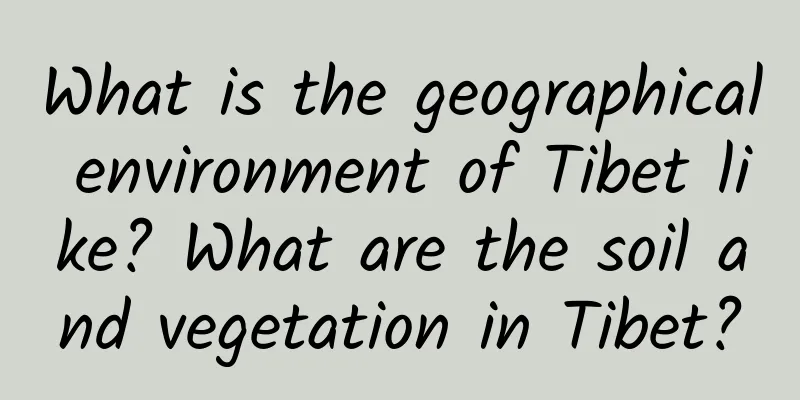What is the geographical environment of Tibet like? What are the soil and vegetation in Tibet?

|
Located in the southwest of the Qinghai-Tibet Plateau in China, it is located between 26°50′ and 36°53′ north latitude and 78°25′ and 99°06′ east longitude. It borders Xinjiang Uygur Autonomous Region to the north, Sichuan Province to the east, Qinghai Province to the northeast, Yunnan Province to the southeast, Myanmar, India, Bhutan, Nepal and other countries to the south, and Kashmir to the west. The land border is more than 4,000 kilometers, with a maximum width of more than 900 kilometers from north to south and a maximum length of more than 2,000 kilometers from east to west. It is an important gateway to China's southwestern border and has no access to the sea. So what is the geographical environment of Tibet like? What is the soil and vegetation in Tibet? Let's take a look at the introduction of Encyclopedia Knowledge Network below! Contents of this article 1. What is the geographical environment like in Tibet? 2. What is the soil vegetation in Tibet? 3. What is the topography of Tibet like? 1What is the geographical environment like in Tibet?Regional LocationThe Tibet Autonomous Region is located in the southwest of the People's Republic of China, spanning 26°50'~36°53'N and 78°25'~99°06'E, with an area of more than 1.22 million square kilometers, accounting for about 1/8 of China's total land area. Among all provinces and regions in China, it ranks second only to the Xinjiang Uygur Autonomous Region, equivalent to the total area of the five countries of Britain, France, Germany, the Netherlands and Luxembourg. It borders the Xinjiang Uygur Autonomous Region and Qinghai Province in the north, Yunnan Province and Sichuan Province in the east and southeast; and Myanmar, India, Bhutan, Nepal and Kashmir in the south and west, with a border line of about 3,842 kilometers. 2What is the soil and vegetation in Tibet?Affected by the complex environment, Tibet has many soil types, which can be divided into four types according to their soil formation characteristics, distribution patterns and main utilization directions: forest soil, agricultural soil, pastoral soil and difficult-to-use soil. Among them, cultivated soil belongs to 16 major categories, mainly mountain shrub steppe soil, tidal soil and subalpine steppe soil, accounting for 33.81%, 12.83% and 12.38% of the cultivated soil area in the region respectively. The vegetation in Tibet is forest, meadow, grassland and desert from southeast to northwest, and can be divided into seven main types, namely broad-leaved forest, coniferous forest, shrub, meadow, grassland, desert and alpine vegetation. According to statistics, there are more than 6,600 species of higher plants in the region, belonging to more than 270 families and more than 1,510 genera, including many plants unique to my country or Tibet, 38 rare plants under national key protection, 40 plants under the key protection of the autonomous region, and another 214 species listed in the appendix of the Convention on International Trade in Endangered Species of Wild Fauna and Flora. 3What is the topography of Tibet like?Tibet is located in the west and south of the Qinghai-Tibet Plateau, accounting for more than half of the area of the Qinghai-Tibet Plateau. Areas above 4,000 meters above sea level account for 85.1% of the total area of the region. It is known as the "Roof of the World" and the "Third Pole of the Earth" and is the highest place in the world. The terrain of the region can be divided into three major areas: the northern Tibetan Plateau, the Yarlung Zangbo River Basin, and the eastern Tibetan Canyon Zone. The mountains in the territory can be roughly divided into two groups, east-west and north-south, mainly including the Himalayas, the Karakoram-Tanggula Mountains, the Kunlun Mountains, the Gangdise-Nianqing Tanggula Mountains and the Hengduan Mountains. There are 5 peaks over 8,000 meters in the territory, among which Mount Everest, the world's highest peak with an altitude of 8,844.43 meters, stands on the China-Nepal border. The plains of Tibet are mainly distributed in several sections of the middle reaches of the Yarlung Zangbo River, which starts from Saga in the west and ends at Milin in the east, as well as the middle and lower reaches of the Lhasa River, Nianchu River, and Niyang River, and the middle reaches of the Yagon Zangbo River, Pengqu River, Lhuntse River, Senge Zangbo River, and Langqin Zangbo River. |
<<: What is the origin of the name Tibet? What are the historical changes in Tibet?
>>: What is the hydrological environment in Tibet like? What are Tibet's natural resources like?
Recommend
What are the treatments for endometriosis?
Many female patients suffer from gynecological di...
How long after pregnancy can an ectopic pregnancy be discovered?
Experts say that how long it takes to detect an e...
Classification, diagnosis, treatment of neuroendocrine tumors, and recommendation for genetic testing!
Author: Ihebari Chi, Chief Physician, Cancer Hosp...
The feeling of early pregnancy and the coming of period
Menstruation is a friend of women and it comes on...
Can massage relieve baby constipation? How to massage baby constipation?
What to do if the baby is constipated? This is a ...
Rash on penis
The penis is the male reproductive organ. If a ra...
When will Itaewon Class be released? Where can I watch the Korean drama Itaewon Class?
Itaewon Class is a drama based on the comic of th...
What is the reason for yellowish and bloody vaginal discharge?
Many gynecological diseases can be manifested thr...
There is a swelling on the left side of the genitals
Many people will find many small bumps on their v...
Drink enough boiled water every day to get "priceless" health
Drink enough boiled water every day to get "...
How many days of menstrual period are considered normal?
The menstrual cycle is also a woman's...
Can I still get pregnant if I take birth control pills during ovulation?
There are many contraceptive methods in life, but...
What tests should be done before giving birth?
In life, pregnant women need to undergo B-ultraso...









